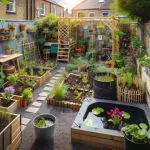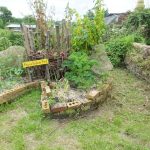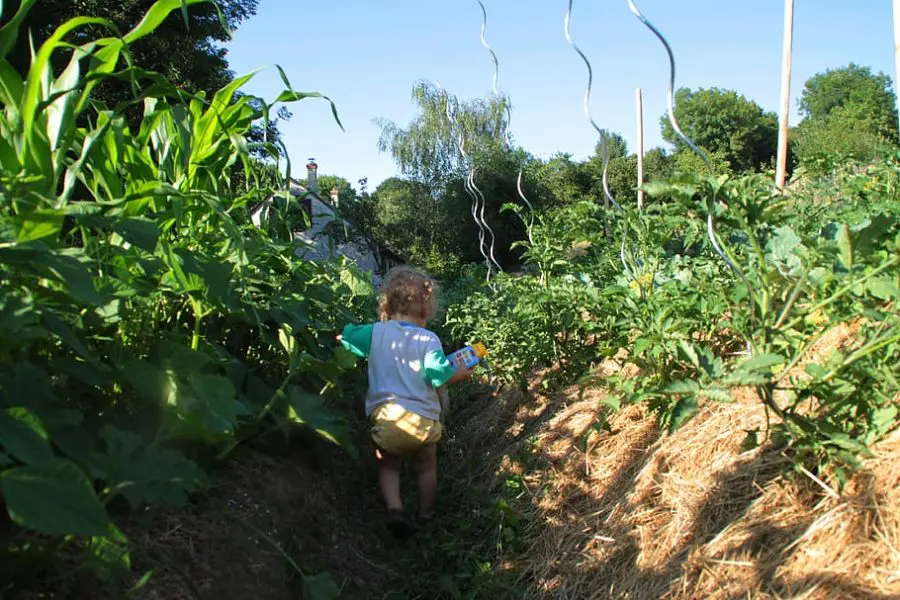
Discover the wonders of the Hugelkultur method! Dive into our guide for creating lush, sustainable gardens with this age-old, eco-friendly technique.
Hugelkultur Method Key Takeaways:
- The Hugelkultur method is a sustainable gardening practice that involves building raised garden beds using layers of decomposing wood, organic matter, and soil.
- This technique improves soil fertility, water retention, and plant health, making it an efficient and eco-friendly choice for gardeners.
Welcome to the world of the Hugelkultur method, a game-changer in sustainable gardening!
This guide will take you through the ins and outs of creating thriving, eco-friendly garden beds using this ancient, yet incredibly relevant, gardening technique.
Let’s embark on this green journey together!
Introduction to the Hugelkultur Method
Hugelkultur, a term derived from the German word for hill culture, is a unique gardening technique that’s gaining popularity in sustainable living circles.
This method, rooted in Eastern Europe, involves creating raised garden beds by piling up organic matter, such as wood chips, grass clippings, and other compostable materials.
The hugelkultur bed, a centerpiece of this approach, offers numerous benefits, including improved soil fertility and water retention.
This method is not just a great way to recycle yard waste but also a means to cultivate fertile soil in small spaces or poor soil conditions.
As we delve deeper into the hugelkultur method, we’ll explore its various aspects, from the basics of setting up a hugelkultur garden bed to the nuances of maintaining it through its first growing season and beyond.
Whether you’re a seasoned gardener or new to the concept, hugelkultur offers a fascinating and effective approach to sustainable gardening.
Embracing Hill Culture in Gardening
Hugelkultur, a German word meaning hill culture, is revolutionizing sustainable gardening. Originating from Eastern Europe, this method transforms garden beds into nutrient-rich havens.
Hügelkultur (German pronunciation: [ˈhyːɡl̩kʊlˌtuːɐ̯]), literally mound bed or mound culture, is a horticultural technique where a mound constructed from decaying wood debris and other compostable biomass plant materials is later (or immediately) planted as a raised bed. Adopted by permaculture advocates, the technique helps to improve soil fertility, water retention, and soil warming, thus benefitting plants grown on or near suchmounds. Wikipedia
The Essence of Hugelkultur Beds
At the heart of hugelkultur lies the hugelkultur bed, ingeniously crafted from organic matter like wood chips, grass clippings, and compostable materials.
These raised beds excel in soil fertility and water retention, making them ideal for both small spaces and areas with poor soil.
As we explore the hugelkultur method, we’ll uncover how to create and maintain these beds, ensuring a thriving garden from the first year onwards.
This method isn’t just about gardening; it’s a testament to eco-friendly practices, turning yard waste into a resource for creating fertile soil.
Understanding the Basics of Hugelkultur
Hugelkultur, a centuries-old practice, is more than just a gardening trend; it’s a fundamental shift in how we approach soil health and plant growth.
This method, deeply rooted in permaculture techniques, involves creating nutrient-rich garden beds using layers of organic matter, such as wood, leaves, and compost.
By understanding the core principles of hugelkultur, gardeners can harness its power to transform their gardens into thriving ecosystems.
This section delves into the key components, the science behind the method, and how it compares to traditional gardening, providing a solid foundation for anyone looking to explore this sustainable gardening technique.
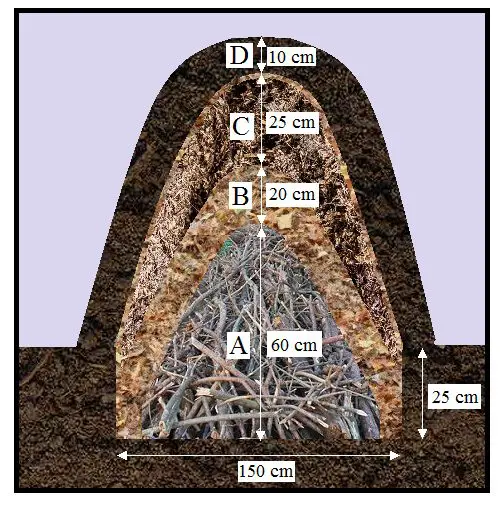
The Foundation of Hugelkultur Gardening
Hugelkultur, a permaculture technique, is more than just piling up organic matter.
It’s a thoughtful process of layering materials like wood, grass clippings, and soil to create a self-sustaining ecosystem.
Key Components of Hugelkultur Beds
A hugelkultur bed starts with large logs, typically from hardwood trees. These logs form the base, slowly decomposing to enrich the soil.
Above this, layers of smaller branches, green leaves, and compost material add to the bed’s structure and nutrient profile.
The Science Behind Hugelkultur
As the wood decomposes, it becomes a sponge for moisture, enhancing soil moisture and reducing the need for watering.
This natural process mimics the forest floor, where fallen wood and leaf litter create a fertile environment, teeming with life and nutrients.
Comparing Hugelkultur with Traditional Gardening Methods
Unlike traditional raised garden beds, hugelkultur beds offer better water retention and soil fertility.
The decomposition process releases nutrients gradually, providing a long-term supply for plants.
This method also utilizes waste wood and yard debris, making it a sustainable and eco-friendly option for gardeners.
Different Variations of Hugelkultur Beds

The hugelkultur method is not a one-size-fits-all approach; it offers a spectrum of variations, each tailored to different gardening needs and environments.
From simple mound cultures to elaborate raised beds, hugelkultur can be adapted to suit various landscapes and preferences.
This section explores the diverse types of hugelkultur beds, including their unique benefits and potential challenges.
Whether you have a sprawling backyard or a modest urban garden, understanding these variations will help you choose the right hugelkultur style to enrich your gardening experience.
Exploring Hugelkultur Variations
Hugelkultur is versatile, with several variations to suit different gardening needs.
From simple mound culture to elaborate raised beds, each style has unique benefits and considerations.
Slash Pile Covered with Soil
This basic form involves covering a pile of slash (woody debris) with soil.
It’s a straightforward method, great for utilizing yard waste. However, it’s prone to drying out and settling over time.
While it takes longer to become productive, adding layers like kitchen scraps can accelerate soil development.
Buried Beds: Fully or Partially
These beds involve burying wood under the ground, either partially or fully. They’re excellent for water retention, especially in dry climates.
The downside is the reduced creation of micro-climates, a feature more prominent in above-ground beds.
Small-to-Medium Beds Above Ground
Ideal for smaller spaces, these beds are built directly on the ground and capped at three feet in height.
They require less material and are easier to build but offer limited water retention compared to larger beds.
Large Beds Above Ground
These towering beds, reaching up to seven feet, create diverse micro-climates and excellent water retention.
However, they demand significant amounts of wood and soil and may not be suitable for all garden spaces due to their size and appearance.
Formal Raised Beds
Merging the hugelkultur method with the aesthetics of traditional raised beds, this variation is visually appealing and functional.
While they may not offer as many micro-climates, they provide good water retention and are easier to harvest from.
Step-by-Step Guide to Building a Hugelkultur Bed
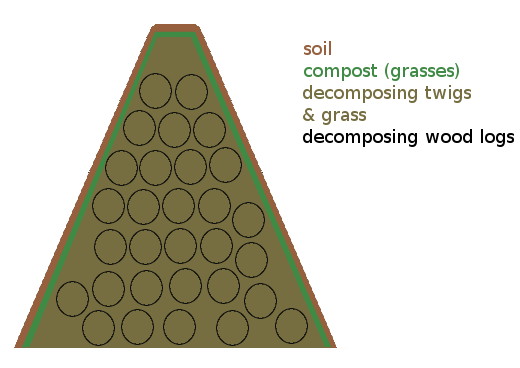
Embarking on the journey of building a hugelkultur bed is an exciting venture for any gardener.
This step-by-step guide is designed to walk you through the process, from the initial planning stages to the final touches.
Whether you’re a seasoned gardener or a beginner, these instructions will help you create a functional and productive hugelkultur bed.
We’ll cover everything from selecting the right location and materials to the actual construction process, ensuring you have all the knowledge needed to successfully build your own hugelkultur garden bed.
Let’s get started on this rewarding path towards sustainable and efficient gardening!
Getting Started with Hugelkultur
Building a hugelkultur bed is a rewarding project that enhances your garden’s productivity.
Here’s a step-by-step guide to creating your own hugelkultur bed, tailored to your garden’s needs.
Choosing the Right Location
Select a spot in your garden that receives adequate sunlight and has good drainage.
Consider the size of the bed and its impact on the surrounding area.
The location should accommodate the bed’s height and width without obstructing garden paths or shading other plants.
Selecting Materials
Start with large logs, preferably from hardwood trees like oak or maple.
Avoid using wood from black walnut or black locusts, as they can inhibit plant growth.
Gather smaller branches, green leaves, and organic kitchen scraps for the subsequent layers.
Construction Process
Begin by laying the large logs as the base. Fill gaps with smaller pieces of wood, creating air pockets that encourage microbial activity.
Add a layer of green leaves or grass clippings, followed by a layer of compost material or kitchen scraps.
Top it off with a layer of good soil, ensuring the top layer is rich in organic matter.
The final height should be about three to six feet, depending on your chosen variation.
Finish with a top mulch layer of straw or leaf litter to protect the bed and retain moisture.
Maintenance and Care for Hugelkultur Beds
Navigating the maintenance and care of hugelkultur beds is key to unlocking their full potential.
This section is your go-to guide for ensuring your hugelkultur garden bed thrives year after year.
From the right watering techniques to soil management and plant selection, we’ll cover all the essentials.
Whether you’re a first-timer or a seasoned hugelkultur enthusiast, these tips will help you maintain a healthy, productive garden.
Let’s dive into the best practices that will keep your hugelkultur beds flourishing and make your gardening journey a rewarding one!
Watering and Irrigation
In the initial stages, hugelkultur beds require consistent watering to kickstart the decomposition process and establish plants.
However, as the wood breaks down and the soil matures, these beds become self-sustaining, requiring less water.
It’s crucial to monitor soil moisture, especially during dry spells, to ensure your plants receive enough hydration.
Employing a drip irrigation system or a soaker hose can provide deep, even watering, encouraging strong root growth.
Soil Management
As the organic matter in hugelkultur beds decomposes, it continually enriches the soil, enhancing its fertility.
To maintain this nutrient-rich environment, supplement with compost or organic fertilizers annually.
Avoid compacting the soil by walking on the beds and consider planting cover crops in the off-season to add nutrients and improve soil structure.
Regularly check for signs of nutrient deficiencies or pH imbalances and adjust your soil amendments accordingly.
Plant Selection and Diversity
Choosing the right plants for your hugelkultur bed can significantly impact its success.
Opt for a variety of plants that thrive in rich, well-drained soil. Root crops, leafy greens, and flowering plants are excellent choices.
Experiment with different plant combinations to take advantage of the bed’s micro-climates and maximize biodiversity.
Remember, diversity in planting not only enhances the beauty of your garden but also contributes to a healthier ecosystem by attracting beneficial insects and promoting pollination.
Seasonal Care and Longevity
Seasonal care is vital for the longevity of your hugelkultur beds. In spring, clear any overwintered mulch and check for any necessary repairs or additions to the bed structure.
Summer is the time to focus on pest management and consistent watering.
As fall approaches, add a fresh layer of mulch to protect the beds during winter.
Every few years, you may need to replenish the top layer of soil and organic matter to maintain the bed’s height and nutrient levels.
With proper care, your hugelkultur beds can remain productive for many years, becoming a cornerstone of your sustainable garden.
Common Challenges and Solutions
Addressing Hugelkultur Issues
While hugelkultur beds are generally low-maintenance, they can face specific challenges.
Understanding these and knowing how to address them ensures your hugelkultur garden bed remains a productive part of your garden.
Potential Issues and Solutions
One common challenge is uneven settling as the wood decomposes. This can be mitigated by packing the wood tightly and filling gaps with soil.
Rodent issues can be reduced by avoiding food scraps in the top layers.
Monitor for pests and diseases regularly, and adjust your gardening practices as needed.
Overcoming Watering Challenges
In the first year, hugelkultur beds may dry out faster as the wood absorbs moisture.
To combat this, ensure consistent watering and consider using mulch to retain soil moisture.
As the wood decomposes, it will hold more water, gradually reducing the need for frequent watering.
Dealing with Decomposition Rates
Different types of wood decompose at varying rates. Softwoods break down faster than hardwoods, affecting the bed’s longevity and nutrient release.
To manage this, mix different types of wood or add more compostable materials to balance the decomposition process.
Adapting to Plant Growth Variations
Plants may grow differently in hugelkultur beds due to varying moisture and nutrient levels.
Observe plant growth patterns and adjust plant placement or bed composition accordingly.
Utilizing companion planting can also enhance growth and yield.
Ensuring Long-Term Bed Health
To maintain long-term health, periodically check the integrity of the bed structure.
Replenish with new layers of organic matter and soil as needed.
This not only maintains the bed’s height but also rejuvenates its nutrient content, ensuring a thriving garden space.
FAQs on the Hugelkultur Method
Hugelkultur raises many questions, especially for those new to the method.
Here, we address some of the most common inquiries to help you better understand and implement this sustainable gardening technique.
Q. How long does a Hugelkultur bed last?
A. A well-constructed hugelkultur bed can last for several years, often up to 20 years or more. The longevity depends on the types of wood used and the environmental conditions.
Q. Can any wood be used for Hugelkultur?
A. While most types of wood can be used, it’s best to avoid woods that are naturally resistant to rotting, like black locust, or those that release substances harmful to plants, like black walnut. Softwoods decompose faster and are generally preferred.
Q. Is Hugelkultur suitable for all climates?
A. Hugelkultur is versatile and can be adapted to various climates. In dry areas, it helps retain moisture, while in wet areas, the raised design aids in drainage. However, the size and composition of the bed might need to be adjusted according to local conditions.
Q. How does Hugelkultur impact soil fertility?
A. Hugelkultur significantly enhances soil fertility. As the wood and organic materials decompose, they release nutrients into the soil, creating a rich, fertile environment. This process also encourages beneficial microbial activity, further boosting soil health.
Q: What is the downside of hugelkultur?
A: The main downside of hugelkultur is the initial labor-intensive setup and the potential for uneven settling as the wood decomposes. It can also take a few years for the beds to reach optimal fertility and water retention levels.
Q: What wood should you not use in hugelkultur?
A: Avoid using wood from allelopathic trees like black walnut, which can inhibit the growth of other plants. Also, wood from trees like black locust and cedar decomposes very slowly and is less ideal for hugelkultur beds.
Q: What grows best in hugelkultur?
A: Hugelkultur beds are great for a wide variety of plants, especially those that thrive in rich, well-drained soil. Root crops, leafy greens, and flowering plants often do well. The bed’s micro-climates also allow for diverse planting.
Q: What is the hugelkultur garden method?
A: The hugelkultur garden method involves creating raised garden beds by piling up decomposing wood, organic matter, and soil. This method improves soil fertility, enhances water retention, and creates a self-sustaining ecosystem for plant growth.
Q: Can you use cardboard in hugelkultur?
A: Yes, cardboard can be used in hugelkultur beds as a layer to suppress weeds and add carbon. It should be free of inks and adhesives and is best used in lower layers.
Q: Can you put food scraps in hugelkultur?
A: Yes, you can put food scraps in hugelkultur beds. They add nutrients and help in the decomposition process. However, it’s best to bury them deep to avoid attracting rodents and pests.
Q: Does hugelkultur attract termites?
A: Hugelkultur beds can potentially attract termites due to the decaying wood. To minimize this risk, avoid using wood prone to termite infestation and locate the beds away from your house.
Q: Can you use straw in hugelkultur?
A: Yes, straw can be used in hugelkultur beds. It’s excellent for mulching and adding carbon to the bed. Straw helps retain moisture and breaks down over time, contributing to the soil structure.
Q: What is the minimum depth for hugelkultur?
A: The minimum depth for hugelkultur beds is typically about 1-1.5 feet, but deeper beds (up to 6 feet) are more effective for water retention and creating varied micro-climates.
Q: What is the lifespan of hugelkultur?
A: The lifespan of a hugelkultur bed can be up to 20 years or more, depending on factors like the types of wood used and environmental conditions.
Q: Can you use firewood for hugelkultur?
A: Yes, firewood can be used for hugelkultur, especially if it’s partially decomposed. It’s a good way to repurpose unused firewood and add bulk to the beds.
Q: Can you use grass clippings in hugelkultur?
A: Grass clippings can be used in hugelkultur beds. They add nitrogen and help in the decomposition process. It’s best to mix them with other materials to prevent matting and improve aeration.
Sustainable Impact of Hugelkultur Conclusion
Hugelkultur isn’t just a gardening method; it’s a sustainable revolution in soil management and water conservation.
By embracing this technique, gardeners contribute to an eco-friendly future, turning waste into wealth and fostering a more natural, self-sustaining garden ecosystem.
Long-Term Benefits for Gardeners and the Environment
The hugelkultur method offers long-term benefits, both for the garden and the environment.
It enhances soil fertility, reduces water usage, and repurposes organic waste.
This approach aligns with permaculture principles, promoting a harmonious relationship between gardening and nature.
Versatile Solution for Diverse Gardening Needs
Whether you’re dealing with poor soil, limited space, or challenging climates, hugelkultur offers a versatile solution.
Its adaptability makes it suitable for various gardening scenarios, from small urban spaces to larger rural landscapes.
Encouraging a Shift in Gardening Practices
Hugelkultur encourages gardeners to rethink traditional practices.
By adopting this method, gardeners can move away from resource-intensive techniques, embracing a more natural, sustainable approach.
This shift not only benefits the immediate garden but also contributes to broader environmental well-being.
Final Thoughts: Embracing Hugelkultur in Your Garden
Incorporating the hugelkultur method into your gardening practices is more than just a technique; it’s a commitment to sustainable living.
As you embark on this journey, remember that each hugelkultur bed is a step towards a healthier, more resilient garden, and a testament to the power of working with nature.





